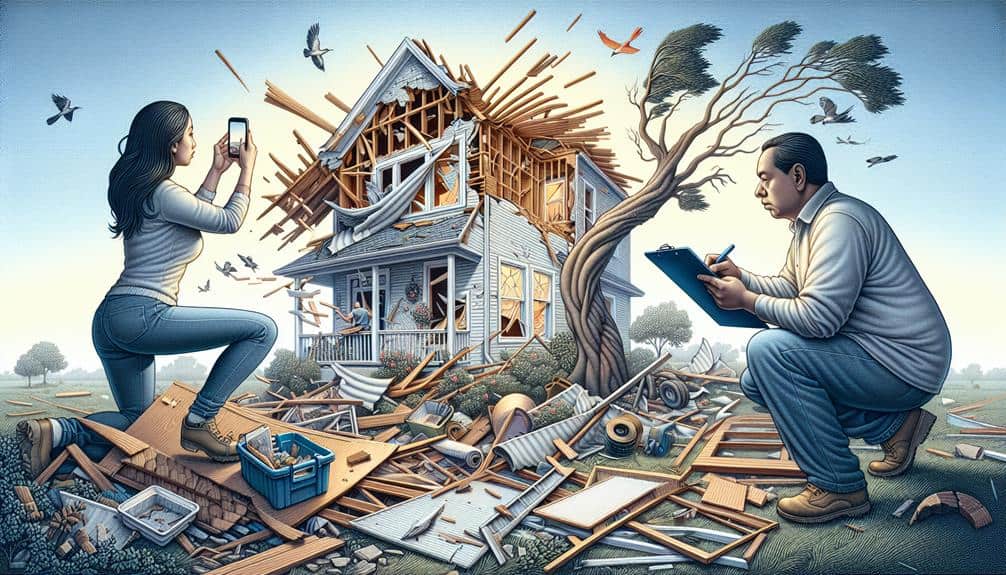Documenting storm damage is essential for legal purposes because it provides solid evidence for insurance claims and legal disputes, ensuring our rights are protected. We need high-resolution photos, videos, and detailed notes to create a credible record. These documents help verify contract work, confirm repairs compliance, and maintain property value. Additionally, they establish a baseline for safety standards and offer historical data vital for disaster preparedness. Thorough documentation not only strengthens our legal cases but also aids in efficient resolution and fair compensation. Understanding these steps will reveal their impact on safeguarding our interests.
Key Points
- Provides undeniable proof of damage, strengthening insurance claims and legal disputes.
- Establishes a timeline and credibility with date and time-stamped photos and videos.
- Facilitates quicker legal and insurance processes with clear, detailed documentation.
- Protects property value by ensuring compliance with safety standards and quality repairs.
Evidence for Insurance Claims
To secure our insurance claims are successful, we need to meticulously gather and document evidence of the storm damage.
First, we should conduct a thorough damage assessment as soon as it's safe. This involves taking high-resolution photos and videos of all affected areas, capturing different angles and close-ups to make sure nothing is missed. We should also document the date and time each piece of evidence is collected, adding credibility to our claims.
Next, we need to compile detailed notes describing the extent of the damage. This includes listing any broken windows, roof damage, water intrusion, or structural issues. It's important to keep receipts and records of any emergency repairs or temporary fixes we undertake to prevent further damage. These documents will be crucial during the claims process.
Additionally, we should gather contact information for any contractors, insurance adjusters, and witnesses who can provide further validation. An organized file containing all this information will streamline the claims process, minimizing delays and disputes.
Supporting Legal Disputes
Beyond insurance claims, detailed documentation of storm damage can also serve as essential evidence when supporting legal disputes. When we're engaged in legal battles, having meticulous records of the damage can greatly strengthen our case. By carefully documenting the extent of the destruction, we can provide undeniable proof of our claims, which is vital in dispute resolution.
Photographs, videos, and written descriptions of the damage can portray a vivid picture of the storm's impact. These records are priceless when presenting our case in court or during negotiations with opposing parties. They help us establish the timeline and severity of the damage, leaving little room for uncertainty or misinterpretation.
Moreover, having this evidence can expedite the legal process. Clear, detailed documentation can reduce the time spent in legal battles by providing all parties with a clear understanding of the situation. This not only aids in achieving a speedier resolution but also minimizes the emotional and financial strain often associated with prolonged disputes.
In a world where our freedom can be jeopardized by unforeseen circumstances, being prepared with solid evidence ensures we've the upper hand in safeguarding our rights and interests during legal disputes.
Verifying Contract Work
When verifying contract work, we must gather proof of completion and evidence of work quality.
Photographs, receipts, and contractor reports are essential to confirm that all tasks were performed as agreed.
This documentation guarantees that we've solid grounds for any legal claims or disputes that may arise.
Proof of Completion
Verifying contract work is necessary to ensure all specified repairs are completed to the agreed standards and can withstand scrutiny during legal disputes. We can achieve this by carefully documenting the completion of each task.
Taking time-stamped photos at various stages of the repair process offers undeniable proof that the work was performed as contracted. These images serve as a visual timeline, capturing the progress and final state of the work done.
In addition to photos, maintaining detailed notes is vital. These notes should include descriptions of the materials used, the techniques applied, and any deviations from the original plan. By doing so, we create a thorough record that can be referenced should any disputes arise. This documentation reassures us that every aspect of the contract has been fulfilled to our satisfaction and legal standards.
Combining time-stamped photos with detailed notes provides a strong framework for proving completion. It guarantees transparency and accountability, empowering us to safeguard our interests.
This meticulous approach to documentation not only serves legal purposes but also grants us the freedom to confidently validate the quality and completion of contracted work.
Work Quality Evidence
Ensuring the quality of work requires diligent documentation and clear evidence to confirm every aspect of the contract is met to our standards. This process is vital, especially after storm damage, to maintain transparency and accountability. We need to systematically collect and organize our evidence to verify the quality of the completed work.
- Photographic Evidence: Capturing high-quality images before and after the work allows us to have clear before and after comparisons. These images should be timestamped to provide an accurate timeline of the repairs.
- Video Recordings: Videos can document the entire repair process, offering a dynamic perspective that photographs alone can't. These recordings can highlight the quality of materials used and the workmanship, ensuring compliance with contractual obligations.
- Detailed Notes: Meticulous records of each step taken during the repair process are essential. These notes should include descriptions of the damage, materials used, and any deviations from the original plan, providing a thorough account of the work performed.
Protecting Property Value
To safeguard our property's value after a storm, we must meticulously document all damage and promptly address necessary repairs. Conducting a thorough property assessment immediately following the event allows us to capture the extent of the damage. This initial assessment is vital for establishing a baseline, enabling us to track the progress of repairs and guarantee that no issues are overlooked.
During the damage assessment, we should photograph and catalog every affected area, noting the severity and specific nature of each issue. Detailed records, including the date and time of each photograph, add credibility and precision to our documentation.
Engaging with professional inspectors can further validate our findings, providing an unbiased evaluation that can be crucial for insurance claims and potential legal disputes.
Ensuring Safety Standards

Adhering to safety standards during the post-storm recovery process not only protects us from immediate hazards but also fortifies our property against future events. This begins with conducting thorough safety examinations, which help identify structural weaknesses and other potential dangers. By documenting these findings, we guarantee our property meets regulatory standards, safeguarding our legal standing and financial investments.
It's essential to follow a systematic approach:
- Initial Assessment: Right after the storm, we need to carry out a preliminary inspection to identify any urgent safety concerns, such as exposed electrical wiring or weakened structures.
- Detailed Review: A thorough review by certified professionals should follow to uncover less obvious damage and verify all aspects of the property meet current safety codes.
- Compliance Documentation: Finally, we must gather all inspection reports, repair receipts, and compliance certificates. This documentation is necessary for legal purposes and future claims.
Historical Documentation
Maintaining a detailed record of past storm damages allows us to establish patterns and assess the long-term resilience of our property. By meticulously documenting each event, we can track changes in weather patterns and understand how our structures withstand repeated exposure to extreme conditions.
This historical documentation is essential for developing effective preservation efforts, ensuring our properties remain robust against future storms.
Furthermore, sharing this data with our community enhances overall awareness and disaster preparedness. When we collectively observe the frequency and impact of severe weather events, we can advocate for stronger building codes and more thorough emergency plans.
Community awareness drives proactive measures, helping us minimize damage and recover more swiftly when storms strike.
By recognizing trends in historical storm damage, we also empower ourselves to make informed decisions about property improvements and investments. Understanding past vulnerabilities allows us to prioritize critical upgrades and allocate resources efficiently.
Importantly, this meticulous record-keeping supports any legal claims we might need to file, providing clear evidence of recurring issues and reinforcing our case for compensation or assistance.
Frequently Asked Questions
How Should Storm Damage Be Photographed for Legal Documentation?
Did you know that drone footage can cover 30% more area than ground photos? We should use drones and take timestamped photos from multiple angles to ensure thorough, accurate documentation of storm damage for legal purposes.
Can Digital Records of Storm Damage Be Used in Court?
Yes, digital evidence of storm damage can be used in court. It's important we make sure it's clear and timestamped. The legal implications require us to be precise and thorough in our documentation to uphold its validity.
What Details Should Be Included in a Written Storm Damage Report?
During damage assessment, we document dates, descriptions, and photographs. Including property specifics, weather conditions, and witness statements strengthens insurance claims. This detailed, objective approach secures our freedom to claim rightful compensation without unnecessary disputes.
How Often Should Storm Damage Documentation Be Updated?
We should update storm damage documentation immediately after each significant weather event. The frequency of updates guarantees the accuracy of our records, which is essential for maintaining detailed, precise information that supports our claims and protects our freedom.
Are There Specific Apps Recommended for Documenting Storm Damage?
Like Sherlock Holmes in search of clues, we can use apps like Encircle and DocuSketch for damage assessment. These tools simplify our insurance claims process by making it easy to document and organize storm damage efficiently.


